Tandem Osmotic Engine Based on Hydrogel Particles with Antipolyelectrolyte and Polyelectrolyte Effect Fuelled by Both Salinity Gradient Modes
Abstract
:1. Introduction
2. Results and Discussion
2.1. Design of Study
2.2. Characterization
2.3. Performance of Combined Salinity Gradient Engine
2.4. Effect of Crosslinking Density on Energy Recovery
2.5. Effect of Zwitterionic Polymeric Backbone
2.6. Performance of SBE@SPA Hydrogel Engine towards Different Loads
2.7. Energy Recovery from the Osmotic Engines of Two Different Assemblies
2.8. Reusability of the Polyelectrolyte and Antipolyelectrolyte over Cycles
3. Materials and Methods
3.1. Materials
3.2. Hydrogel Particles Sample Preparation
3.3. Characterization
3.4. Salinity Gradient Engine Setup
3.5. Calculation of Energy Recovery and Power Generation
4. Conclusions
Author Contributions
Funding
Institutional Review Board Statement
Informed Consent Statement
Acknowledgments
Conflicts of Interest
References
- Höök, M.; Tang, X. Depletion of Fossil Fuels and Anthropogenic Climate Change—A Review. Energy Policy 2013, 52, 797–809. [Google Scholar] [CrossRef] [Green Version]
- Shafiee, S.; Topal, E. When Will Fossil Fuel Reserves Be Diminished? Energy Policy 2009, 37, 181–189. [Google Scholar] [CrossRef]
- Helfer, F.; Lemckert, C.; Anissimov, Y.G. Osmotic Power with Pressure Retarded Osmosis: Theory, Performance and Trends–A Review. J. Membr. Sci. 2014, 453, 337–358. [Google Scholar] [CrossRef] [Green Version]
- Achilli, A.; Childress, A.E. Pressure Retarded Osmosis: From the Vision of Sidney Loeb to the First Prototype Installation—Review. Desalination 2010, 261, 205–211. [Google Scholar] [CrossRef]
- Cheng, Z.L.; Li, X.; Chung, T.-S. The Forward Osmosis-Pressure Retarded Osmosis (FO-PRO) Hybrid System: A New Process to Mitigate Membrane Fouling for Sustainable Osmotic Power Generation. J. Membr. Sci. 2018, 559, 63–74. [Google Scholar] [CrossRef]
- Nagy, E.; Hegedüs, I.; Tow, E.W.; Lienhard, V.J.H. Effect of Fouling on Performance of Pressure Retarded Osmosis (PRO) and Forward Osmosis (FO). J. Membr. Sci. 2018, 565, 450–462. [Google Scholar] [CrossRef]
- He, Y.; Huang, Z.; Chen, B.; Tsutsui, M.; Shui Miao, X.; Taniguchi, M. Electrokinetic Analysis of Energy Harvest from Natural Salt Gradients in Nanochannels. Sci. Rep. 2017, 7, 13156. [Google Scholar] [CrossRef] [PubMed] [Green Version]
- Tufa, R.A.; Pawlowski, S.; Veerman, J.; Bouzek, K.; Fontananova, E.; di Profio, G.; Velizarov, S.; Goulão Crespo, J.; Nijmeijer, K.; Curcio, E. Progress and Prospects in Reverse Electrodialysis for Salinity Gradient Energy Conversion and Storage. Appl. Energy 2018, 225, 290–331. [Google Scholar] [CrossRef]
- Jia, Z.; Wang, B.; Song, S.; Fan, Y. Blue Energy: Current Technologies for Sustainable Power Generation from Water Salinity Gradient. Renew. Sust. Energy Rev. 2014, 31, 91–100. [Google Scholar] [CrossRef]
- Logan, B.E.; Elimelech, M. Membrane-Based Processes for Sustainable Power Generation Using Water. Nature 2012, 488, 313–319. [Google Scholar] [CrossRef]
- Xin, W.; Zhang, Z.; Huang, X.; Hu, Y.; Zhou, T.; Zhu, C.; Kong, X.-Y.; Jiang, L.; Wen, L. High-Performance Silk-Based Hybrid Membranes Employed for Osmotic Energy Conversion. Nat. Commun. 2019, 10, 3876. [Google Scholar] [CrossRef]
- Ramon, G.Z.; Feinberg, B.J.; Hoek, E.M.V. Membrane-Based Production of Salinity-Gradient Power. Energy Environ. Sci. 2011, 4, 4423–4434. [Google Scholar] [CrossRef]
- Rica, R.; Ziano, R.; Salerno, D.; Mantegazza, F.; van Roij, R.; Brogioli, D. Capacitive Mixing for Harvesting the Free Energy of Solutions at Different Concentrations. Entropy 2013, 15, 1388–1407. [Google Scholar] [CrossRef] [Green Version]
- Brogioli, D.; Ziano, R.; Rica, R.A.; Salerno, D.; Kozynchenko, O.; Hamelers, H.V.M.; Mantegazza, F. Exploiting the Spontaneous Potential of the Electrodes Used in the Capacitive Mixing Technique for the Extraction of Energy from Salinity Difference. Energy Environ. Sci. 2012, 5, 9870–9880. [Google Scholar] [CrossRef] [Green Version]
- Brogioli, D.; Ziano, R.; Rica, R.A.; Salerno, D.; Mantegazza, F. Capacitive Mixing for the Extraction of Energy from Salinity Differences: Survey of Experimental Results and Electrochemical Models. J. Colloid Interface Sci. 2013, 407, 457–466. [Google Scholar] [CrossRef] [PubMed]
- Bijmans, M.F.M.; Burheim, O.S.; Bryjak, M.; Delgado, A.; Hack, P.; Mantegazza, F.; Tenisson, S.; Hamelers, H.V.M. CAPMIX-Deploying Capacitors for Salt Gradient Power Extraction. Energy Procedia 2012, 20, 108–115. [Google Scholar] [CrossRef] [Green Version]
- Marino, M.; Kozynchenko, O.; Tennison, S.; Brogioli, D. Capacitive Mixing with Electrodes of the Same Kind for Energy Production from Salinity Differences. J. Condens. Matter Phys. 2016, 28, 114004. [Google Scholar] [CrossRef] [PubMed]
- Brogioli, D. Extracting Renewable Energy from a Salinity Difference Using a Capacitor. Phys. Rev. Lett. 2009, 103, 058501. [Google Scholar] [CrossRef]
- Brogioli, D.; Zhao, R.; Biesheuvel, P.M. A Prototype Cell for Extracting Energy from a Water Salinity Difference by Means of Double Layer Expansion in Nanoporous Carbon Electrodes. Energy Environ. Sci. 2011, 4, 772–777. [Google Scholar] [CrossRef] [Green Version]
- Sales, B.B.; Saakes, M.; Post, J.W.; Buisman, C.J.N.; Biesheuvel, P.M.; Hamelers, H.V.M. Direct Power Production from a Water Salinity Difference in a Membrane-Modified Supercapacitor Flow Cell. Environ. Sci. Technol. 2010, 44, 5661–5665. [Google Scholar] [CrossRef]
- Sales, B.; Burheim, O.S.; Liu, F.; Schaetzle, O.; Buisman, C.; Hamelers, H.V.M. Impact of Wire Geometry in Energy Extraction from Salinity Differences Using Capacitive Technology. Environ. Sci. Technol. 2012, 46, 12203–12208. [Google Scholar] [CrossRef] [Green Version]
- Hatzell, M.C.; Cusick, R.D.; Logan, B.E. Capacitive Mixing Power Production from Salinity Gradient Energy Enhanced through Exoelectrogen-Generated Ionic Currents. Energy Environ. Sci. 2014, 7, 1159–1165. [Google Scholar] [CrossRef]
- Ahualli, S.; Jiménez, M.L.; Fernández, M.M.; Iglesias, G.; Brogioli, D.; Delgado, Á.V. Polyelectrolyte-Coated Carbons Used in the Generation of Blue Energy from Salinity Differences. Phys. Chem. Chem. Phys. 2014, 16, 25241–25246. [Google Scholar] [CrossRef] [Green Version]
- Ahualli, S.; Iglesias, G.R.; Fernández, M.M.; Jiménez, M.L.; Delgado, Á.V. Use of Soft Electrodes in Capacitive Deionization of Solutions. Environ. Sci. Technol. 2017, 51, 5326–5333. [Google Scholar] [CrossRef]
- Kim, T.; Logan, B.E.; Gorski, C.A. High Power Densities Created from Salinity Differences by Combining Electrode and Donnan Potentials in a Concentration Flow Cell. Energy Environ. Sci. 2017, 10, 1003–1012. [Google Scholar] [CrossRef]
- La Mantia, F.; Pasta, M.; Deshazer, H.D.; Logan, B.E.; Cui, Y. Batteries for Efficient Energy Extraction from a Water Salinity Difference. Nano Lett. 2011, 11, 1810–1813. [Google Scholar] [CrossRef] [PubMed]
- Olsson, M.; Wick, G.L.; Isaacs, J.D. Salinity Gradient Power: Utilizing Vapor Pressure Differences. Science 1979, 206, 452–454. [Google Scholar] [CrossRef] [PubMed]
- Liu, F.; Schaetzle, O.; Sales, B.B.; Saakes, M.; Buisman, C.J.; Hamelers, H.V. Effect of additional charging and current density on the performance of capacitive energy extraction based on Donnan Potential. Energy Environ. Sci. 2012, 5, 8642–8650. [Google Scholar] [CrossRef] [Green Version]
- Tan, G.; Xu, N.; Gao, D.; Zhu, X. Facile Designed Manganese Oxide/Biochar for Efficient Salinity Gradient Energy Recovery in Concentration Flow Cells and Influences of Mono/Multivalent Ions. ACS Appl. Mater. Interfaces 2021, 13, 19855–19863. [Google Scholar] [CrossRef]
- Zhu, X.; Yang, W.; Hatzell, M.C.; Logan, B.E. Energy Recovery from Solutions with Different Salinities Based on Swelling and Shrinking of Hydrogels. Environ. Sci. Technol. 2014, 48, 7157–7163. [Google Scholar] [CrossRef]
- Arens, L.; Weißenfeld, F.; Klein, C.O.; Schlag, K.; Wilhelm, M. Osmotic Engine: Translating Osmotic Pressure into Macroscopic Mechanical Force via Poly(Acrylic Acid) Based Hydrogels. Adv. Sci. 2017, 4, 1700112. [Google Scholar] [CrossRef] [Green Version]
- Buchholz, F.L.; Graham, A.T. Modern Superabsorbent Polymer Technology; Wiley-VCH: New York, NY, USA, 1997; p. 279. [Google Scholar]
- Bui, T.; Cao, V.D.; Wang, W.; Kjøniksen, A.-L. Recovered Energy from Salinity Gradients Utilizing Various Poly(Acrylic Acid)-Based Hydrogels. Polymers 2021, 13, 645. [Google Scholar] [CrossRef] [PubMed]
- Bui, T.Q.; Magnussen, O.-P.; Cao, V.D.; Wang, W.; Kjøniksen, A.-L.; Aaker, O. Osmotic Engine Converting Energy from Salinity Difference to a Hydraulic Accumulator by Utilizing Polyelectrolyte Hydrogels. Energy 2021, 232, 121055. [Google Scholar] [CrossRef]
- Zavahir, S.; Krupa, I.; AlMaadeed, S.; Tkac, J.; Kasák, P. Polyzwitterionic Hydrogels in Engines Based on the Antipolyelectrolyte Effect and Driven by the Salinity Gradient. Environ. Sci. Technol. 2019, 53, 9260–9268. [Google Scholar] [CrossRef]
- Available online: https://www.chemimpex.com/2-methacryloyloxy-ethyl-dimethyl-3-sulfopropyl-ammonium-hydroxide (accessed on 11 November 2021).
- Available online: https://www.chemicalbook.com/ChemicalProductProperty_EN_CB7315600.htm (accessed on 11 November 2021).
- Khoo, S.C.; Phang, X.Y.; Ng, C.M.; Lim, K.L.; Lam, S.S.; Ma, N.L. Recent Technologies for Treatment and Recycling of Used Disposable Baby Diapers. Process Saf. Environ. Prot. 2019, 123, 116–129. [Google Scholar] [CrossRef]
- Zhao, C.; Zhao, J.; Li, X.; Wu, J.; Chen, S.; Chen, Q.; Wang, Q.; Gong, X.; Li, L.; Zheng, J. Probing Structure-Antifouling Activity Relationships of Polyacrylamides and Polyacrylates. Biomaterials 2013, 34, 4714–4724. [Google Scholar] [CrossRef]
- Mary, P.; Bendejacq, D.D.; Labeau, M.-P.; Dupuis, P. Reconciling Low- and High-Salt Solution Behavior of Sulfobetaine Polyzwitterions. J. Phys. Chem. B 2007, 111, 7767–7777. [Google Scholar] [CrossRef] [PubMed]
- Kasák, P.; Kroneková, Z.; Krupa, I.; Lacík, I. Zwitterionic Hydrogels Crosslinked with Novel Zwitterionic Crosslinkers: Synthesis and Characterization. Polymer 2011, 52, 3011–3020. [Google Scholar] [CrossRef]
- Ahmad, M.B.; Huglin, M.B. DSC Studies on States of Water in Crosslinked Poly(Methyl Methacrylate-Co-n-Vinyl-2-Pyrrolidone) Hydrogels. Polym. Int. 1994, 33, 273–277. [Google Scholar] [CrossRef]
- Morisaku, T.; Watanabe, J.; Konno, T.; Takai, M.; Ishihara, K. Hydration of Phosphorylcholine Groups Attached to Highly Swollen Polymer Hydrogels Studied by Thermal Analysis. Polymer 2008, 49, 4652–4657. [Google Scholar] [CrossRef]
- Bui, T.Q.; Cao, V.D.; Wang, W.; Nguyen, T.H.; Kjøniksen, A.-L. Energy Lost in a Hydrogel Osmotic Engine Due to a Pressure Drop. Ind. Eng. Chem. Res. 2021, 60, 13348–13357. [Google Scholar] [CrossRef]
- Lin, W.; Zhang, J.; Wang, Z.; Chen, S. Development of Robust Biocompatible Silicone with High Resistance to Protein Adsorption and Bacterial Adhesion. Acta Biomater. 2011, 7, 2053–2059. [Google Scholar] [CrossRef]
- Mohammad, S.A.; Dolui, S.; Kumar, D.; Mane, S.R.; Banerjee, S. L-Histidine-Derived Smart Antifouling Biohybrid with Multistimuli Responsivity. Biomacromolecules 2021, 22, 3941–3949. [Google Scholar] [CrossRef]
- Kuang, J.; Messersmith, P.B. Universal Surface-Initiated Polymerization of Antifouling Zwitterionic Brushes Using a Mussel-Mimetic Peptide Initiator. Langmuir 2012, 28, 7258–7266. [Google Scholar] [CrossRef] [Green Version]
- Chiao, Y.-H.; Chen, S.-T.; Ang, M.B.M.; Patra, T.; Castilla-Casadiego, D.; Fan, R.; Almodovar, J.; Hung, W.-S.; Wickramasinghe, R. High-Performance Polyacrylic Acid-Grafted PVDF Nanofiltration Membrane with Good Antifouling Property for the Textile Industry. Polymers 2020, 12, 2443. [Google Scholar] [CrossRef]
- Xu, J.; Lee, H. Anti-Biofouling Strategies for Long-Term Continuous Use of Implantable Biosensors. Chemosensors 2020, 8, 66. [Google Scholar] [CrossRef]
- Shao, Q.; Jiang, S. Molecular Understanding and Design of Zwitterionic Materials. Adv. Mater. 2015, 27, 15–26. [Google Scholar] [CrossRef]
- Racovita, S.; Trofin, M.-A.; Loghin, D.F.; Zaharia, M.-M.; Bucatariu, F.; Mihai, M.; Vasiliu, S. Polybetaines in Biomedical Applications. Int. J. Mol. Sci. 2021, 22, 9321. [Google Scholar] [CrossRef]
- Mosnacek, J.; Osička, J.; Popelka, A.; Zavahir, S.; Ben-Hamadou, R.; Kasák, P. Photochemical Grafting of Polysulfobetaine onto Polyethylene and Polystyrene Surfaces and Investigation of Long-Term Stability of the Polysulfobetaine Layer in Seawater. Polym. Adv. Technol. 2018, 29, 1930–1938. [Google Scholar] [CrossRef]

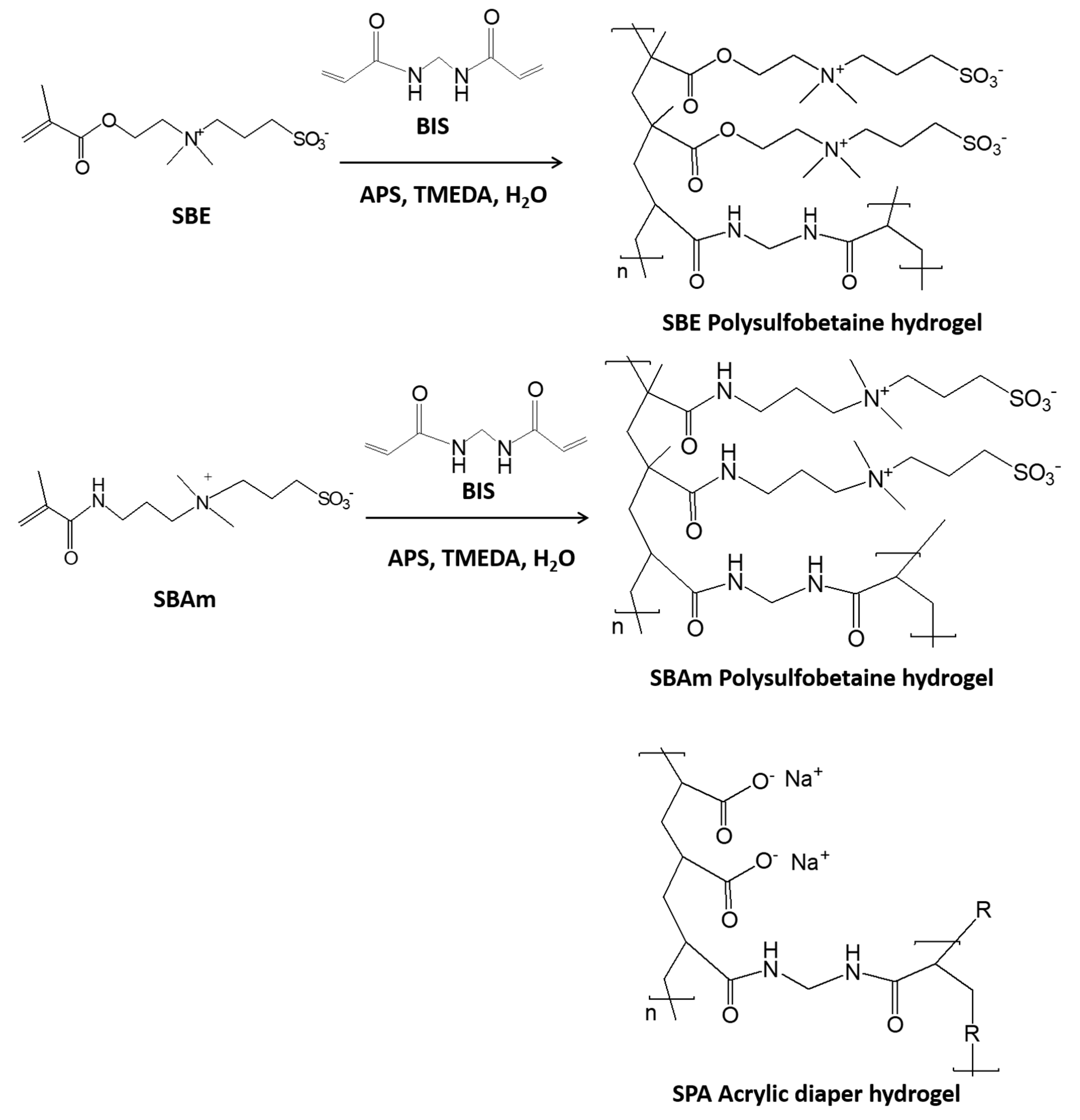
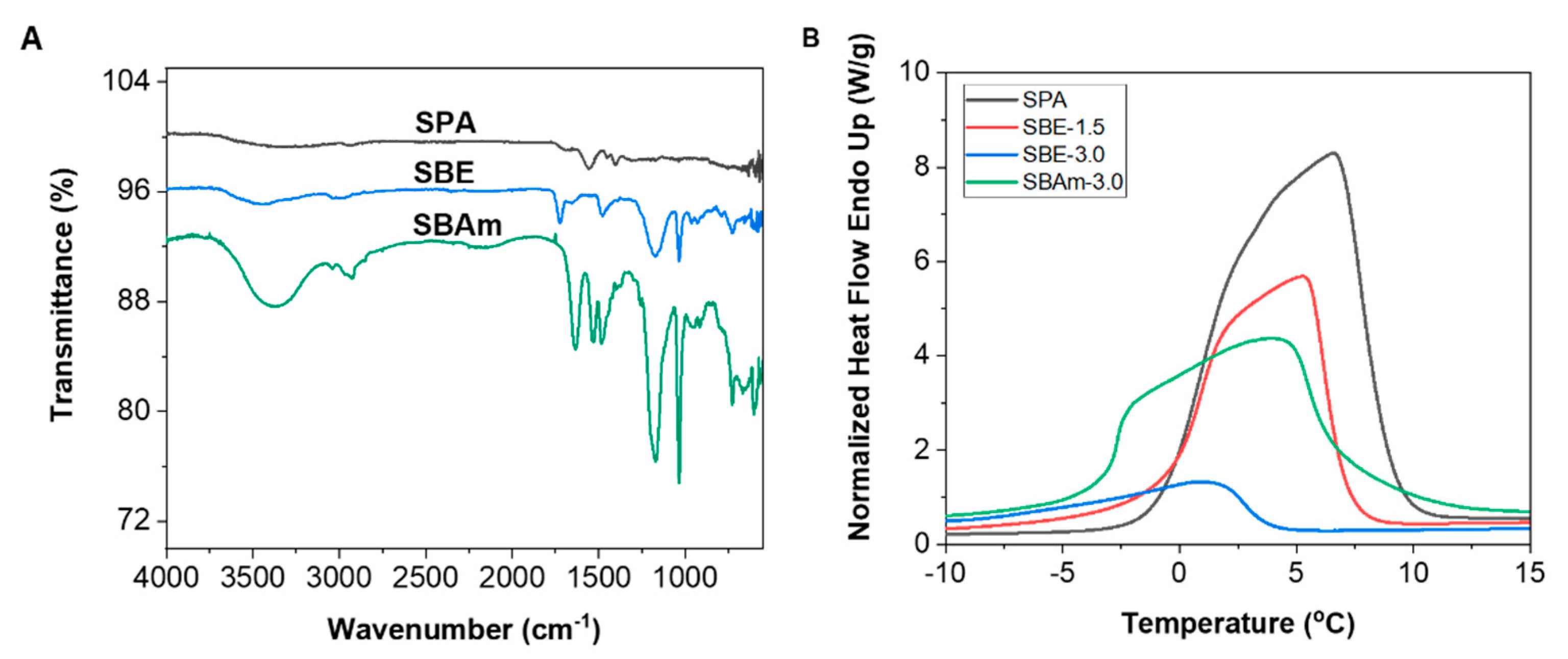

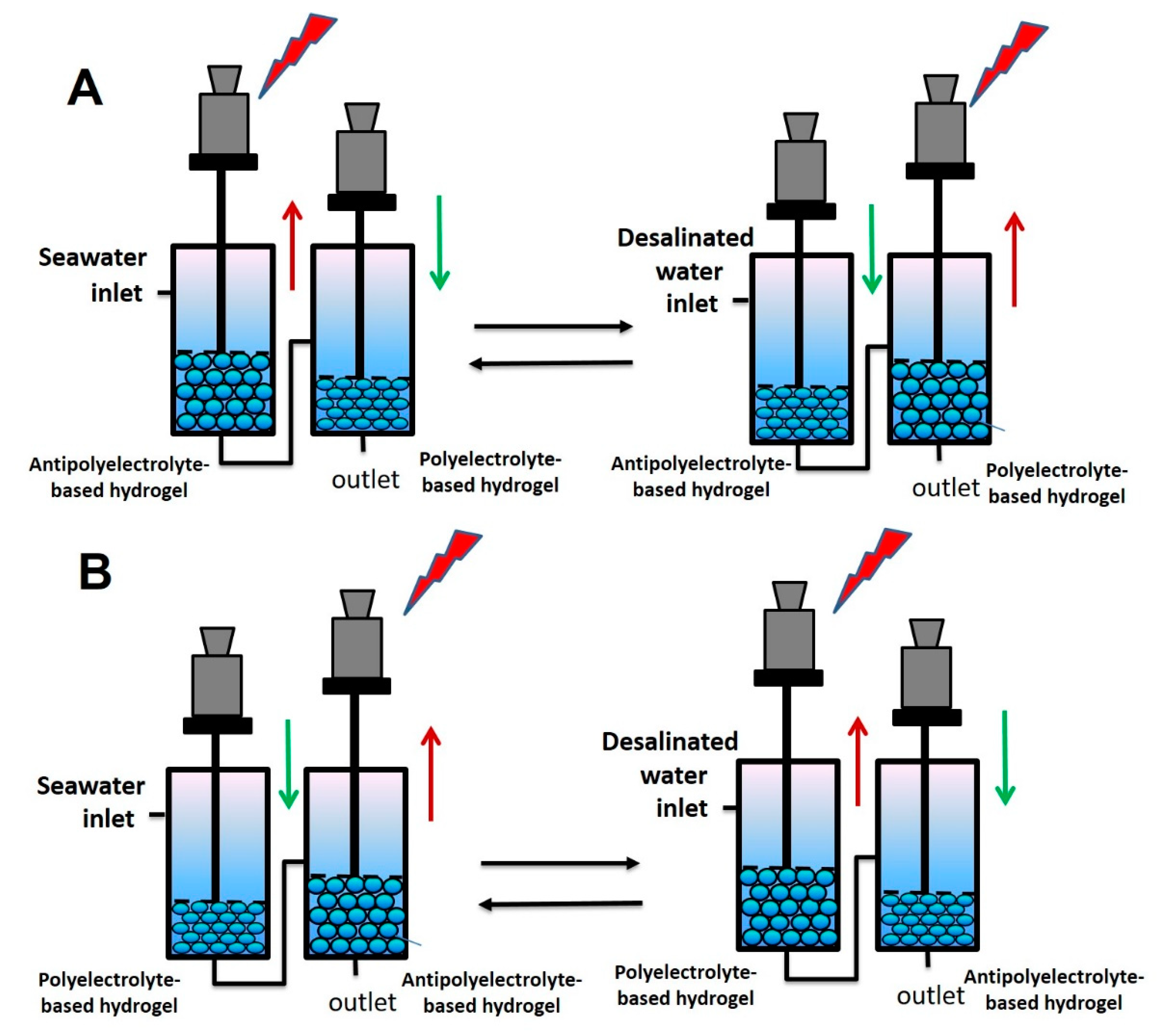
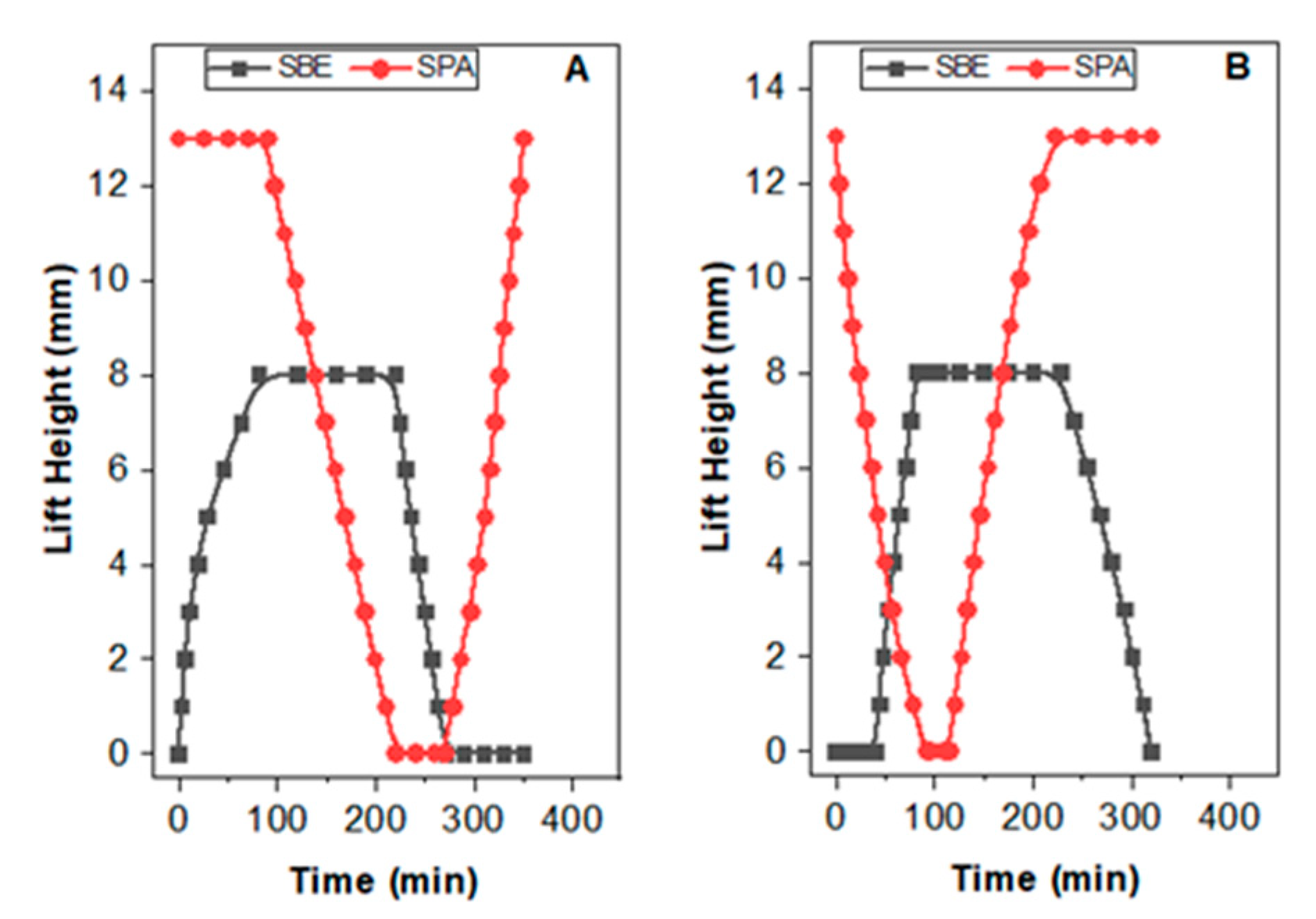
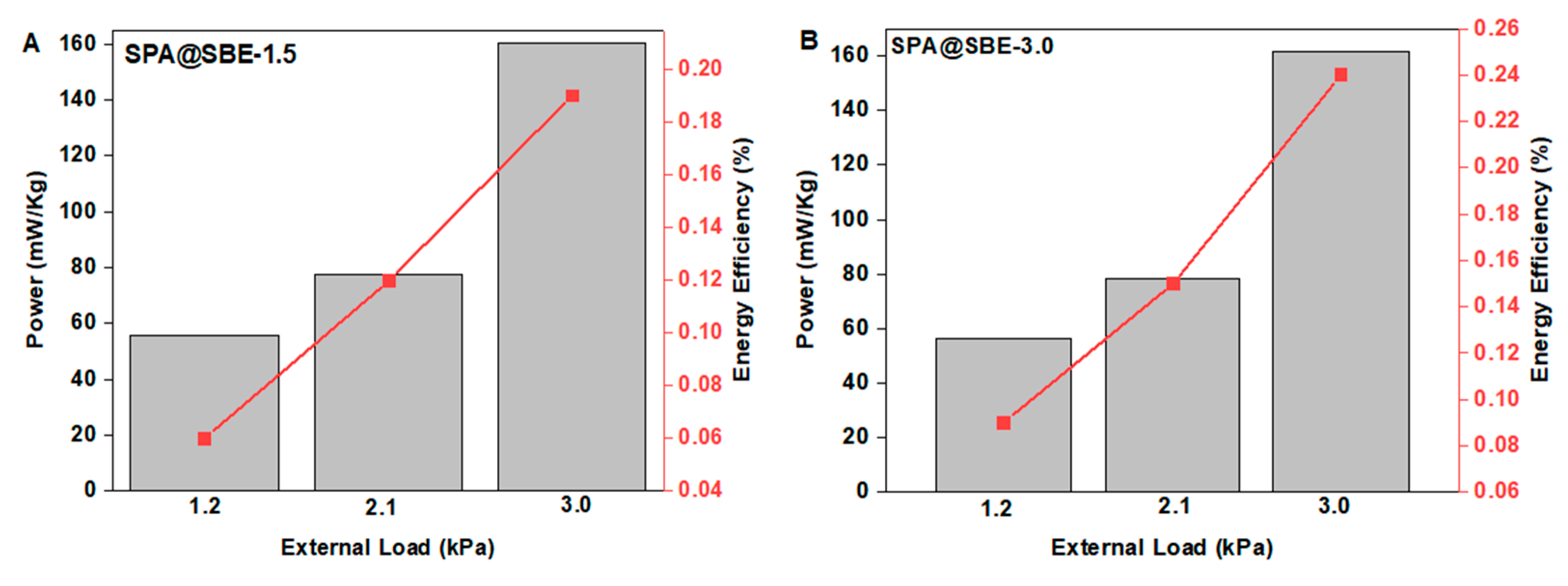
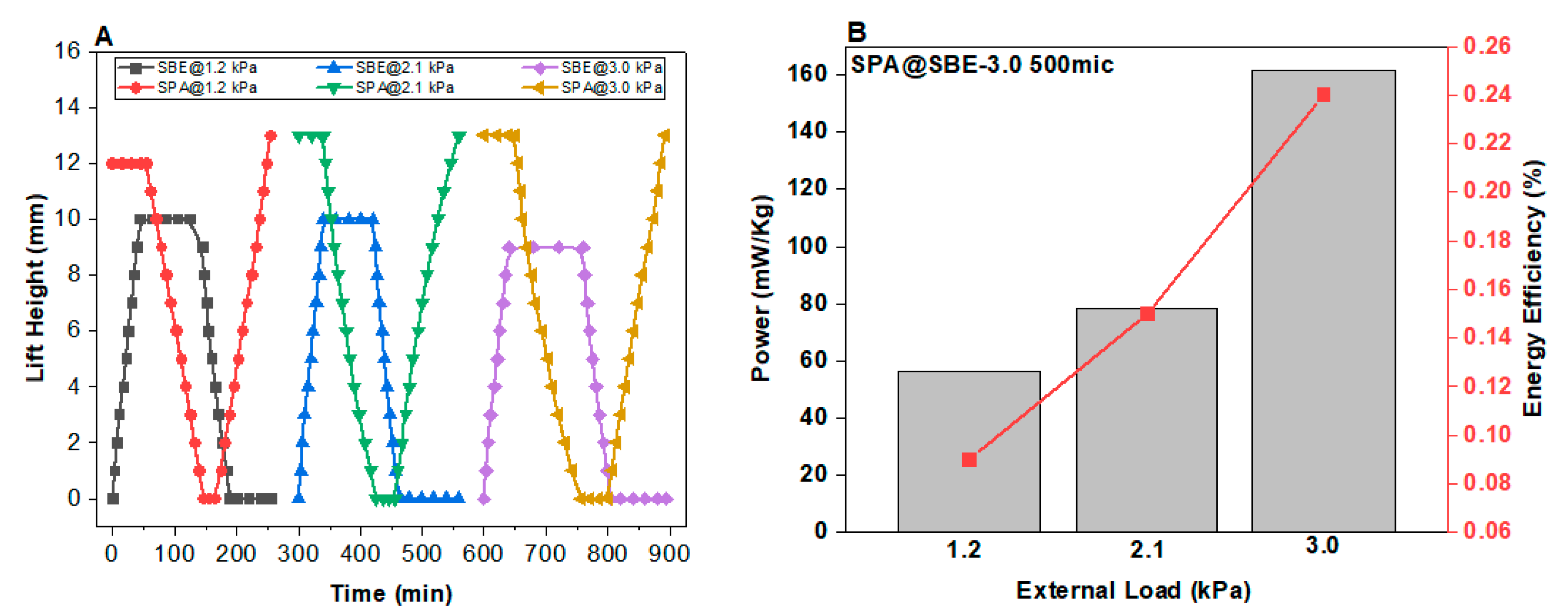

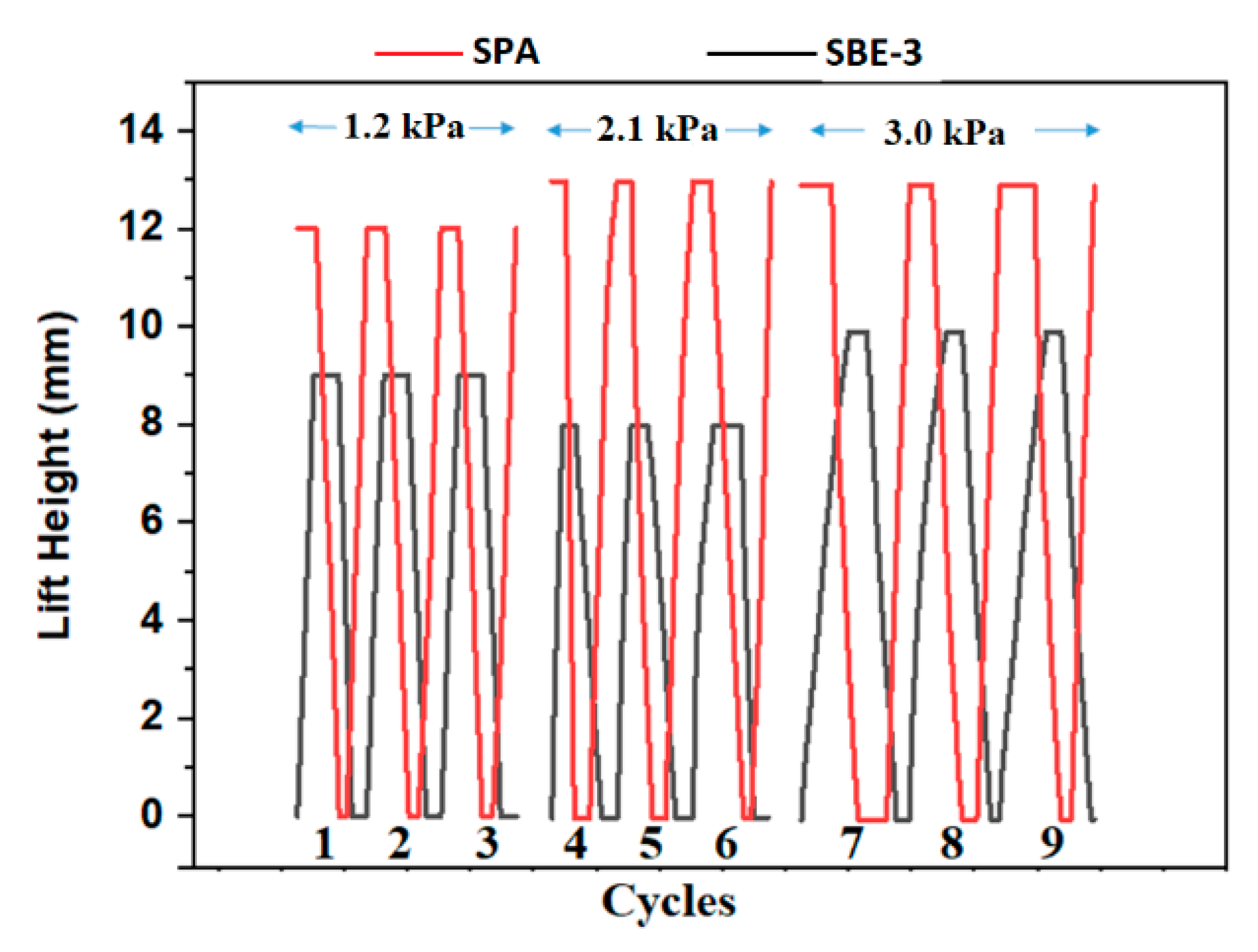
| Sample Code | CD | BIS (mol %) | DSDI (g g−1) | DS(3.6 wt% NaCl) (g g−1) | DSNaCl/DSDI |
|---|---|---|---|---|---|
| SBE-1.5 | 1.5 | 1.5 | 6.6 | 13.2 | 2.0 |
| SBE-3.0 | 3.0 | 3.0 | 5.2 | 8.4 | 1.6 |
| SBAm-3.0 | 3.0 | 3.0 | 3.7 | 11.7 | 3.2 |
| SPA | NA | NA | 182.0 | 59.4 | 0.3 |
| Sample Code | EWC (%) | Wtf (%) | Wnf (%) |
|---|---|---|---|
| SBE-1.5 | 84.7 | 51.6 | 33.1 |
| SBE-3.0 | 80.8 | 45.8 | 35 |
| SBAm-3.0 | 82.0 | 41.6 | 40.4 |
| SPA | 99.4 | 90.6 | 8.8 |
| Connection | Load (kPa) | (W × 10−6) | E, 1 h (J × 103) | , 1 kg (mW kg−1) | E, 1 h, 1 kg (J kg−1) |
|---|---|---|---|---|---|
| A-SBE@SPA | 2.1 | 1.72 ± 0.02 | 6.11 ± 0.05 | 76.81 ± 0.04 | 275.89 ± 0.32 |
| B-SPA@SBE | 2.1 | 1.52 ± 0.01 | 5.33 ± 0.03 | 65.72 ± 0.02 | 274.20 ± 0.08 |
| Connection Setup | Sample Code | Particle Size of Sulfobetaine Hydrogel (µm) | Load (kPa) | (W × 10−6) | E, 1 h (J × 10−3) | , 1 kg (mW kg−1) | E, 1 h, 1 kg (J kg−1) |
|---|---|---|---|---|---|---|---|
| A | SPA@SBE-3.0 | 500 | 1.2 | 1.42 ± 0.02 | 5.13 ± 0.06 | 56.32 ± 0.07 | 202.93 ± 0.12 |
| A | SPA@SBE-3.0 | 500 | 2.1 | 2.41 ± 0.06 | 8.51 ± 0.21 | 78.33 ± 0.12 | 281.09 ± 0.44 |
| A | SPA@SBE-3.0 | 500 | 3.0 | 3.74 ± 0.05 | 13.39 ± 0.17 | 161.61 ± 0.09 | 581.14 ± 0.35 |
| A | SPA@SBE-3.0 | 700 | 1.2 | 1.19 ± 0.02 | 4.43 ± 0.04 | 55.94 ± 0.02 | 201.28 ± 0.08 |
| A | SPA@SBE-3.0 | 700 | 2.1 | 1.72 ± 0.02 | 6.11 ± 0.05 | 76.81 ± 0.04 | 275.89 ± 0.32 |
| A | SPA@SBE-3.0 | 700 | 3.0 | 2.48 ± 0.01 | 8.82 ± 0.03 | 159.04 ± 0.02 | 571.24 ± 0.07 |
| A | SPA@SBE-1.5 | 700 | 1.2 | 1.03 ± 0.01 | 3.62 ± 0.03 | 55.63 ± 0.02 | 200.21 ± 0.06 |
| A | SPA@SBE-1.5 | 700 | 2.1 | 1.79 ± 0.06 | 6.44 ± 0.23 | 77.52 ± 0.14 | 278.18 ± 0.49 |
| A | SPA@SBE-1.5 | 700 | 3.0 | 3.04 ± 0.05 | 10.63 ± 0.09 | 160.53 ± 0.05 | 577.03 ± 0.20 |
| A | SPA@SBAm-3.0 | 500 | 3.0 | 13.53 ± 0.15 | 48.84 ± 0.54 | 186.31 ± 0.38 | 670.04 ± 1.37 |
| Connection | Sample Code | Article Size of Sulfobetaine Hydrogel (µm) | Load (kPa) | (W × 10−6) | E, 1 h (J × 10−3) | , 1 kg (mW kg−1) | E, 1 h, 1 kg (J kg−1) |
|---|---|---|---|---|---|---|---|
| A | SPA@SBE-3.0 | 500 | 3.0 | 3.74 ± 0.05 | 13.39 ± 0.17 | 161.61 ± 0.09 | 581.14 ± 0.35 |
| A | SPA@SBAm-3.0 | 500 | 3.0 | 13.53 ± 0.15 | 48.84 ± 0.54 | 186.31 ± 0.38 | 670.04 ± 1.37 |
Publisher’s Note: MDPI stays neutral with regard to jurisdictional claims in published maps and institutional affiliations. |
© 2021 by the authors. Licensee MDPI, Basel, Switzerland. This article is an open access article distributed under the terms and conditions of the Creative Commons Attribution (CC BY) license (https://creativecommons.org/licenses/by/4.0/).
Share and Cite
Padmanabhan, A.C.; Han, D.S.; Zavahir, S.; Tkac, J.; Kasak, P. Tandem Osmotic Engine Based on Hydrogel Particles with Antipolyelectrolyte and Polyelectrolyte Effect Fuelled by Both Salinity Gradient Modes. Gels 2021, 7, 232. https://doi.org/10.3390/gels7040232
Padmanabhan AC, Han DS, Zavahir S, Tkac J, Kasak P. Tandem Osmotic Engine Based on Hydrogel Particles with Antipolyelectrolyte and Polyelectrolyte Effect Fuelled by Both Salinity Gradient Modes. Gels. 2021; 7(4):232. https://doi.org/10.3390/gels7040232
Chicago/Turabian StylePadmanabhan, Anjali Cheeramthodi, Dong Suk Han, Sifani Zavahir, Jan Tkac, and Peter Kasak. 2021. "Tandem Osmotic Engine Based on Hydrogel Particles with Antipolyelectrolyte and Polyelectrolyte Effect Fuelled by Both Salinity Gradient Modes" Gels 7, no. 4: 232. https://doi.org/10.3390/gels7040232
APA StylePadmanabhan, A. C., Han, D. S., Zavahir, S., Tkac, J., & Kasak, P. (2021). Tandem Osmotic Engine Based on Hydrogel Particles with Antipolyelectrolyte and Polyelectrolyte Effect Fuelled by Both Salinity Gradient Modes. Gels, 7(4), 232. https://doi.org/10.3390/gels7040232









